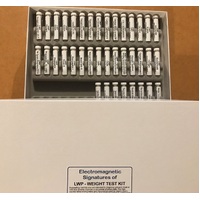LWP Weight Management Kit
38 vials, including flat tray storage box
Vial size: 10 x 50mm
Box: White Cardboard Flat Tray Storage Box with Inlay Structure of Cells for the Vials
Hormones, etc. that affect metabolism, blood glucose levels, gastric emptying and appetite control. 38 vials for use in kinesiolology, chiropractic, naturopathy etc. and by practitioners of Vega, Mora, Bicom etc. 38 vials
All these vials are available in other kits; Hormones, Body Biochemicals & Amino Acids. This kit simply brings the ones involved in weight managment into one place.
WT 01 Anandamide
May increase appetite.
WT 02 Arginine
An amino acid. Involved with glucose control mechanism in blood; enhances fat metabolism; involved in insulin production; stimulates human growth hormone.
WT 03 Carnitine
An amino acid. Major role in transferring fatty acids into cells where used as energy sources; mobilising fatty deposits in obesity.
WT 04 CART
Modulates the action of leptin and neuropeptide Y and so reduces appetite.
WT 05 CCK / Cholecystokinin
Stimulates a feeling of satiety; may regulate feeding as a “stop eating” signal.
WT 06 Corticotropin Releasing Hormone / CRH
Involved in the regulation of food intake.
WT 07 Cortisol / Hydrocortisone
The principal gluccocorticoid; increases blood glucose levels by increasing cellular utilisation of proteins and fats as energy sources thus conserving glucose; stimulates liver cells to produce glucose from amino acids and fats.
WT 08 Cyclic AMP / Cyclic Adenosine-3’,5’ - monophosphate
Causes adipose cells to break down triglycerides and release fatty acids more rapidly; stimulates thyroid cells to secrete more thyroid hormone.
WT 09 Dipeptidyl Peptidase IV
Arrests biological activity of GLP1 and Substance P.
WT 10 Epinephrine/ Adrenaline
Slows digestion, increases blood sugar.
WT 11 Exendin (9-39)
Reduces glucose levels; competes for the same brain receptors as GLP1 and so blocks the effect of GLP1 and stimulates appetite.
WT 12 Galanin
Stimulates the appetite.
WT 13 Ghrelin
Increases appetite; may be a hormonal link between stomach, hypothalamus and pituitary and so regulate energy balance; regulates growth hormone secretions; may signal to the hypothalamus when an increase in metabolic efficiency is necessary.
WT 14 Glucagon
Raises blood sugar levels by accelerating breakdown of glycogen into glucose in the liver, converting other nutrients into glucose in the liver, and releasing glucose into the blood – opposes the action of insulin.
WT 15 Glucagon-Like Peptide 1/GLP1
Stimulates production of insulin; inhibits production of glucagon and gastric emptying; reduces appetite; lowers blood glucose in people with diabetes.
WT 16 Glucocorticoids
Conversion of non-carbohydrates into energy.
WT 17 Glycogen
The principal carbohydrate storage material in the body; plays an important role in controlling blood sugar levels.
WT 18 Glycogen Phosphorylase A
Involved in converting glycogen to glucose.
WT 19 Glycogen Synthase
Involved in converting glucose to glycogen.
WT 20 Growth Hormone Inhibiting Hormone / Somatostatin
Inhibits secretion of insulin and glucagons and slows absorption of nutrients from the gastro-intestinal tract.
WT 21 Human Growth Hormone / Somatotropin
Helps to maintain muscle and bone mass and promote healing of injuries and tissue repair; speeds up the breakdown of liver glycogen into glucose; excess production may cause diabetes mellitus.
WT 22 Insulin
Decreases blood sugar levels.
WT 23 Leptin
Released by fat cells as they synthesise triglycerides; reduces appetite; non-insulin dependent diabetes.
WT 24 Melanocyte-Stimulating Hormone / MSH
Suppresses appetite.
WT 25 Neuromedin B
Involved in blood glucose control; suppresses the appetite.
WT 26 Neuropeptide Y
Stimulates appetite; causes increased storage of ingested food as fat; reduces energy expenditure.
WT 27 Orexin B
Generated when blood sugar levels drop, so acting as a trigger to eat.
WT 28 Pheylalanine
An amino acid. Precursor of tyrosine and therefore dopamine, norepinephrine (noradrenaline) and epinephrine (adrenaline), so affects blood sugar levels and fat metabolism; necessary for thyroid; involved in weight control.
WT 29 Prostaglandin E2 / PGE2
Acts on adenylate cyclase to enhance the production of cyclic AMP.
WT 30 Protein Tyrosine Phosphatase / PTP1B
Inhibits signalling of leptin and insulin1; may explain resistance to leptin and insulin; likely to be important in obesity and type 2 diabetes; drug research now being carried out to find drugs to inhibit PTP1B.
WT 31 Reverse T3 / 3,3’,5’-Triiodothyronine
Reverse T3 and T3 are secreted in an inverse relationship allowing the thyroid to adjust the amount of thyroid activity; blocks the action of T3 by binding with the receptor sites.
WT 32 Serotonin
Decreases carbohydrate cravings; provides a feeling of fullness; enhances mood.
WT 33 Thyroid-Stimulating Hormone / TSH
Stimulates thyroid gland to produce its hormones.
WT 34 Thyrotropin Releasing Hormone / TRH
Stimulates anterior pituitary to secrete TSH.
WT 35 Thyroxine / Tetraiodothyronine / T4
Converted into T3; increase rate at which cells release energy from carbohydrates.
WT 36 Triiodothyronine/T3
Regulates metabolism by stimulating carbohydrate and fat breakdown.
WT 37 Urocortin Inhibits appetite.
WT 38 Val-Pro-Asp-Pro-Arg
Research on rats indicates that this is an appetite suppressant.
(TKweight)
| SKU | TKweight |
Be The First To Review This Product!
Help other Equilibrium Kinesiology Supplies users shop smarter by writing reviews for products you have purchased.












